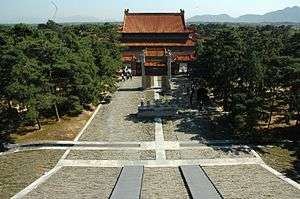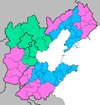Tangshan
| Tangshan 唐山市 | |
|---|---|
| Prefecture-level city | |
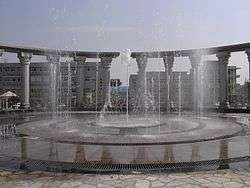 | |
| Nickname(s): Phoenix City | |
.png) Location of Tangshan City jurisdiction in Hebei | |
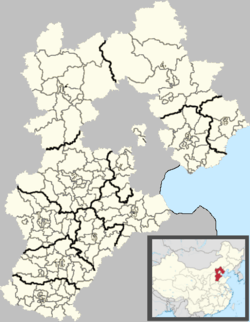 Tangshan Location of the city centre in Hebei | |
| Coordinates: 39°37′23″N 118°10′34″E / 39.62306°N 118.17611°ECoordinates: 39°37′23″N 118°10′34″E / 39.62306°N 118.17611°E | |
| Country | People's Republic of China |
| Province | Hebei |
| Government | |
| • Party Secretary | Jiao Yanlong (焦彦龙) |
| • Mayor | Ding Xiufeng (丁绣峰) |
| Area | |
| • Prefecture-level city | 13,472 km2 (5,202 sq mi) |
| • Urban | 3,874 km2 (1,496 sq mi) |
| • Metro | 3,874 km2 (1,496 sq mi) |
| Population (2010 census) | |
| • Prefecture-level city | 7,536,521 |
| • Density | 560/km2 (1,400/sq mi) |
| • Urban | 3,187,171 |
| • Urban density | 820/km2 (2,100/sq mi) |
| • Metro | 3,187,171 |
| • Metro density | 820/km2 (2,100/sq mi) |
| Time zone | UTC+8 (China Standard) |
| Postal code | 063000 |
| Area code(s) | 315 |
| ISO 3166 code | CN-HE-02 |
| GDP | ¥605.383 billion (2016) |
| GDP per capita | ¥80458 (2016) |
| License Plate Prefix | 冀B |
| Website |
tangshan |
| Tangshan | |||||||||||||||||||
| Chinese | 唐山 | ||||||||||||||||||
|---|---|---|---|---|---|---|---|---|---|---|---|---|---|---|---|---|---|---|---|
| |||||||||||||||||||
Tangshan (Chinese: 唐山; pinyin: Tángshān) is a largely industrial prefecture-level city in the northeast of Hebei province. It has become known for the 1976 Tangshan earthquake which measured 7.8 on the Richter scale, flattening much of the city and killing at least 255,000 residents according to official estimates. The city has since been rebuilt, has become a tourist attraction and has among the 10 largest ports in China.[1]
The city of Tangshan is approximately 149 kilometers, 92 miles or 80 nautical miles east by south east of the country's capital city of Beijing. It takes roughly 2 hours by road to get from Tangshan to Beijing and 1 hour by road to reach Tianjin.[2]
Tangshan's prefecture population was 7,577,289 at the 2010 census, with 3,187,171 in the built-up (or metro) area made of the 6 urban core districts.
Etymology
Tangshan is named after Dacheng Mountain (大城山), which is also called Mount Tang, in the middle of Tangshan city.
In A.D. 645, Li Shimin- an emperor of Tang Dynasty and his army were stationed at Dacheng Mountain on his way back from Korean Peninsula. Unfortunately, Caofei, his beloved concubine, died here. In order to commemorate his Caofei, he named the mountain with the name of the state—Tang. Later, the name of the mountain became the name of the city.
History
Early history
Tangshan has a long history, with ancient humans living in the area as early as 4,000 years ago. It fell within the territory of the Guzhu Kingdom (1600 BC) at the time of the Shang Dynasty and later became a part of the State of Yan, one of the seven Warring States (403 – 221 BC). During the Han Dynasty (206 BC – 220 AD) it became part of the ancient province of Youzhou. It was under the jurisdiction of Yongping Province and Zunhua State successively during the Qing dynasty (1644–1911).
Tang, Ming and Qing dynasties
Tangshan was a village at the time of the Tang dynasty (619–907) and developed further in agriculture, oil exploitation and ceramics during the Ming Dynasty (1368–1644).
During the Hundred Days' Reform in the late Qing dynasty, the Kaiping Mining Administration was established in the third year of the Guangxu Emperor (1877). In 1878, Qiaotun town was established at Tangshan and renamed Tangshan Town in 1889. In 1938, Tangshan City was formally founded. The administrative system of Tangshan during the Republic of China Republican era continued to follow the Qing system. In 1929, Zhili Province changed its name to Hebei Province. On January 28, 1939, because of Tangshan's special economic and political position, the Eastern-Hebei Anti-communist Government established Tangshan City which was initially called “Tangshan Municipal Government” and later changed to “Tangshan Municipal Office”. After Japan surrendered in 1945, the Chinese Nationalist Party in Peking (now known as Beijing) took over the political control of Tangshan from Japan and set up an Administration Inspectors Office. In April 1946, it was decided at the 132nd Meeting of the CPC Hebei Provincial Committee to set up Tangshan City and on May 5 of the same year, the Tangshan Municipal government was founded.
People's Republic
After the establishment of the People's Republic of China on October 1, 1949, Tangshan remained a provincially administered municipality with 12 areas under its jurisdiction. In March 1955, it was decided at the 2nd session of the first People's Congress of Tangshan City to change Tangshan Municipal people's government to Tangshan people's committee without changing its administration areas.
On April 28, 1958, the State Council approved the establishment of Tangshan prefecture. On August 29, 1958, it was decided at the Seventh Session of the first People's Congress of Hebei Province to move the Tangshan Commissioner Office from Changli County to Tangshan City.
The CPC Central Committee decided to designate Tangshan city as one of the 45 cities open to the world on June 3, 1959. On June 8, 1959, the CPC Hebei Provincial Committee and the Hebei Provincial People's Congress decided to combine the Tangshan Commissioners Office and the Tangshan People's Committee into the Tangshan People's Committee. On April 2, 1960, the State Council officially approved the abolition of Tangshan prefecture. Qinhuangdao city, Qian'an, Changli, Laoting, Baodi, Yutian, Jixian County and Zunhua which were formerly administrated by Tangshan Prefecture were incorporated into the Tangshan Municipality. Luanxian County, Fengrun County (formerly a district) and Baigezhuang Farm were also incorporated into Tangshan Municipality. Meanwhile, Tangshan became a provincially administered municipality.
On May 23, 1961, the State Council approved the reinstatement of Tangshan prefecture, which was adopted at the 14th Meeting of the Hebei Provincial People's Committee on June 3, 1959. Tangshan prefecture and Tangshan municipality were separated again and Tangshan turned into a specially administered municipality.
The Tangshan Municipal Revolutionary Committee affiliated to the Revolutionary Committee of Tangshan Region was set up on January 6, 1968, On March 11, 1978, Tangshan turned to be a provincially administered municipality.
In October 1982, it was decided at the Seventh People's Congress of Tangshan city to abolish the Tangshan Municipal Revolutionary Committee and set up the Tangshan Municipal People's Government.
The State Council approved the move on March 3, 1983 and thereafter implemented the city-governing-county system. On May 13, 1983, the Hebei Provincial People's Government announced the cancellation of the Civic Administration office of Tangshan region, which ceased operation on May 15, 1983.
On December 15, 1984, the State Council approved Tangshan city as one of 13 national “comparatively big” cities.
1976 Tangshan earthquake
Tangshan suffered an earthquake of magnitude 7.8 (7.5 according to official reports) at 3:42 am on July 28, 1976, which resulted in many casualties. The official death toll was 255,000, but many experts believe that the actual number of fatalities was two to three times that number, making it the most destructive earthquake in modern history. As a result of the earthquake, most of the town had to be rebuilt. The earthquake was depicted in the 2010 movie Aftershock.
Geography
Tangshan is located in the central section of the Bohai Economic Rim, facing the Bohai Sea to the south. Lying on the North China Plain, Tangshan is adjacent to the Yan Mountains to the north, borders the Luan River and Qinhuangdao to the east, and to the west adjoins with Beijing and Tianjin. Because of its location in the northeast of Hebei, it is a strategic area and a corridor linking two China's north and northeast regions. The largest river in the prefecture is the Luan River.
Climate
Tangshan has a monsoon-influenced, humid continental climate (Köppen Dwa), with cold and very dry winters, and hot, rainy summers. Spring and autumn are short with some rainfall. The monthly 24-hour average temperature in January is −5.1 °C (22.8 °F), and 25.7 °C (78.3 °F) in July, and the annual mean is 11.5 °C (52.7 °F). Close to 60% of the annual precipitation of 610 millimetres (24.0 in) falls in July and August alone. The frost-free period lasts 180−190 days, and the area receives 2,600−2,900 hours of sunshine annually.
| Climate data for Tangshan (1971−2000) | |||||||||||||
|---|---|---|---|---|---|---|---|---|---|---|---|---|---|
| Month | Jan | Feb | Mar | Apr | May | Jun | Jul | Aug | Sep | Oct | Nov | Dec | Year |
| Record high °C (°F) | 12.1 (53.8) |
19.5 (67.1) |
23.5 (74.3) |
32.5 (90.5) |
36.1 (97) |
39.6 (103.3) |
39.6 (103.3) |
36.0 (96.8) |
33.1 (91.6) |
31.4 (88.5) |
22.7 (72.9) |
13.2 (55.8) |
39.6 (103.3) |
| Average high °C (°F) | 0.9 (33.6) |
4.1 (39.4) |
10.7 (51.3) |
19.6 (67.3) |
25.2 (77.4) |
29.1 (84.4) |
30.2 (86.4) |
29.4 (84.9) |
25.9 (78.6) |
19.1 (66.4) |
9.8 (49.6) |
3.0 (37.4) |
17.3 (63.1) |
| Daily mean °C (°F) | −5.1 (22.8) |
−2.0 (28.4) |
4.6 (40.3) |
13.1 (55.6) |
19.0 (66.2) |
23.4 (74.1) |
25.7 (78.3) |
24.7 (76.5) |
20.0 (68) |
12.8 (55) |
4.0 (39.2) |
−2.5 (27.5) |
11.5 (52.7) |
| Average low °C (°F) | −10.2 (13.6) |
−7 (19) |
−0.8 (30.6) |
7.1 (44.8) |
13.0 (55.4) |
18.2 (64.8) |
21.7 (71.1) |
20.5 (68.9) |
14.6 (58.3) |
7.5 (45.5) |
−0.7 (30.7) |
−7 (19) |
6.4 (43.5) |
| Record low °C (°F) | −22.7 (−8.9) |
−19.8 (−3.6) |
−14.6 (5.7) |
−4.7 (23.5) |
3.5 (38.3) |
9.4 (48.9) |
14.6 (58.3) |
11.2 (52.2) |
4.7 (40.5) |
−5.6 (21.9) |
−14.5 (5.9) |
−17 (1) |
−22.7 (−8.9) |
| Average precipitation mm (inches) | 4.3 (0.169) |
4.4 (0.173) |
9.6 (0.378) |
21.3 (0.839) |
42.7 (1.681) |
86.6 (3.409) |
192.8 (7.591) |
162.5 (6.398) |
48.2 (1.898) |
23.5 (0.925) |
9.9 (0.39) |
4.5 (0.177) |
610.3 (24.028) |
| Average precipitation days (≥ 0.1 mm) | 2.4 | 2.4 | 3.4 | 4.6 | 6.6 | 9.0 | 12.9 | 10.7 | 6.4 | 4.8 | 3.0 | 2.0 | 68.2 |
| Source: Weather China | |||||||||||||
Air pollution
As air pollution in China is at an all-time high, several Hebei cities are among the most polluted in the country and Tangshan has some of the worst air quality in China. Reporting on China's airpocalypse has been accompanied by what seems like a monochromatic slideshow of the country's several cities smothered in thick smog. According to a survey made by "Global voices China" in February 2013, 7 cities in Hebei including Xingtai, Shijiazhuang, Baoding, Handan, Langfang, Hengshui and Tangshan, are among China's 10 most polluted cities.[3]
Economy
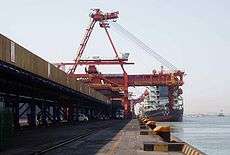
Tangshan is an important heavy industrial city in North China. Its output include machinery, motor vehicles, chemicals, textiles, glass, petroleum products, and cement. It has been a coal-mining center since late Qing Dynasty, as Guangdong merchant Tong King-sing opened the first coal mine using modern techniques in Kaiping in 1877.[4] Since the construction of the Caofeidian Project, it has hosted large iron and steel plants, chemical projects, and electricity plants. It is China's largest steel-producing city.[5] Tangshan is also called the "porcelain capital of North China." [6]
Modern industry in China first arose in Tangshan. The second railway in China – after the abortive Woosung Railway in Shanghai – was the six-mile track laid between Hsukochuang and Tangshan which opened in 1881;[7] this eventually grew into the Imperial Railroad of North China and China's modern Jingshan and Jingha Railways. The first fire-resistant material manufactory and the first and largest cement manufactory were constructed in Tangshan as well.
In 2008, the GDP of Tangshan was ¥356.119 billion, ranked No. 1 among all the prefecture-level cities in Hebei Province, and No. 19 in China. GDP per capita reached ¥48,190 ($6,817).
Tangshan’s GDP in 2011 reached 544.2billion RMB, up 11.7% over the same period of last year. The overall fiscal revenue reached 55.5 billion RMB, among which the general budget revenue reached 25.56 billion RMB, up 26.6% and 30.5% respectively. The per capita disposable income of urban and rural residents reached 21785RMB and 9460RMB respectively, an increase of 11.4% and 13.8%, leading the first in Hebei Province.
Industrial zone
- Caofeidian New Zone.
Administration
The prefecture-level city of Tangshan administers 14 county-level divisions including 7 districts, 4 counties and 3 county-level cities.
| Map | ||||||
|---|---|---|---|---|---|---|
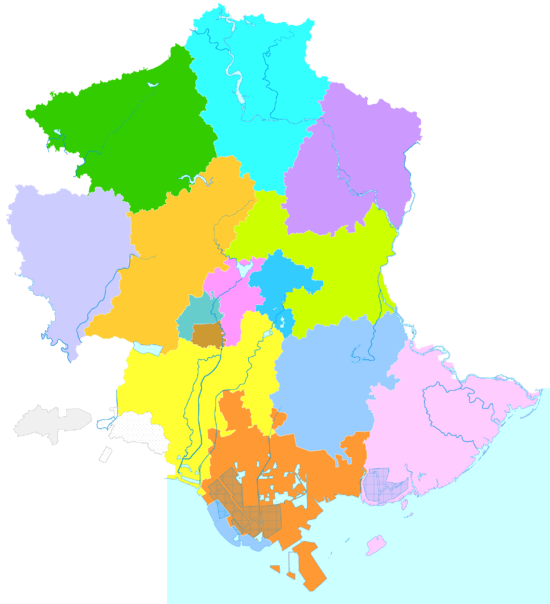 3
4
3. (Hangu MD)
4. (Lutai EDZ)
| ||||||
| Name | Hanzi | Hanyu Pinyin | Population (2010 census)[8] | Area (km²) | Density (/km²) | |
| Lubei District | 路北区 | Lùběi Qū | 743,504 | 112 | 6,638 | |
| Lunan District | 路南区 | Lùnán Qū | 311,076 | 355 | 876 | |
| ↳Hangu Management District* | 汉沽管理区 | Hàngū Guǎnlǐqū | ||||
| ↳Lutai Economic Development Zone* | 芦台经济技术开发区 | Lútái Jīngjì Jìshù Kāifāqū | ||||
| Guye District | 古冶区 | Gǔyě Qū | 358,461 | 253 | 1,417 | |
| Kaiping District | 开平区 | Kāipíng Qū | 262,571 | 252 | 1,042 | |
| Fengrun District | 丰润区 | Fēngrùn Qū | 916,092 | 1,334 | 687 | |
| Fengnan District | 丰南区 | Fēngnán Qū | 595,467 | 1,568 | 380 | |
| Built-up area | 3,187,171 | 3,874 | 823 | |||
| Caofeidian District | 曹妃甸区 | Cáofēidiān Qū | 184,931 | 700 | 264 | |
| Zunhua City | 遵化市 | Zūnhuà Shì | 737,011 | 1,521 | 485 | |
| Qian'an City | 迁安市 | Qiān'ān Shì | 728,160 | 1,208 | 603 | |
| Luanzhou City | 滦州市 | Luánzhōu Shì | 554,315 | 999 | 555 | |
| Luannan County | 滦南县 | Luánnán Xiàn | 584,518 | 1,270 | 460 | |
| Laoting County | 乐亭县 | Làotíng Xiàn | 526,222 | 1,308 | 402 | |
| Qianxi County | 迁西县 | Qiānxī Xiàn | 390,128 | 1,439 | 271 | |
| Yutian County | 玉田县 | Yùtián Xiàn | 684,833 | 1,165 | 588 | |
| *Hangu Management District and Lutai Economic Development Zone is subordinate to Lunan District but formally part of Binhai New Area in Tianjin. | ||||||
Education
Universities and colleges
- North China University of Science and Technology (formerly named Hebei United University), which was co-established by Hebei Polytechnic University and North China Coal Medical College in May 2010 [9]
- Tangshan Normal University
- Tangshan College
- Hebei University of Science and Technology Tangshan Branch
High Schools
- Tangshan NO.1 high school (founded 1902), one of the most famous high schools in China [http://www.ts-edu.net.cn]
- Hebei Tangshan Foreign Language School
Culture


Specialty
- Diet
- Wanlixiangshang Roast Chicken (万里香烧鸡)
- Chessboard pancake (棋子烧饼)
- Honey sugar (蜂蜜麻糖)
- Peanut crisp (花生酥糖)
- big gezhe (大格摺)
- small gezhe (小格摺)
- Dry Fruits
- Chinese chestnut (板栗)
- Walnut
- Mineral products
Traditional Arts
- Pingju
- Tangshan Shadow Play (唐山皮影)
- Laoting drums (乐亭大鼓)
Tourism
- Eastern Tombs of the Qing Dynasty
- Anti-Seismic Monument, located in Anti-Seismic Square
- Tangshan Nanhu Park (Lunan District)
- Kailuan National Mine Park (Lunan District)
- Tangshan science and Technology Museum (Lubei District)
Religion
- Datang Xingguo Chan Temple (大唐兴国禅寺), a Buddhist temple
- Jingzhong Mountain, a religious shrine for the believers of Confucianism, Buddhism, and Taoism
- Two Christian churches and a mosque.
Transport
Air
- Tangshan Sannühe Airport, 20 kilometers from the city center, in Fengrun District
Rail
- Beijing–Harbin Railway
- Tianjin–Shanhaiguan Railway
- Beijing-Qinhuangdao Railway
- Tianjin-Shanxi Railway
Roads
- China National Highway 102, in the south of Fengrun District
- China National Highway 112, ring road encircling Beijing, traversing the west side of Tangshan's urban area
- China National Highway 205, which runs along the eastern and southern front of the urban area
- G1 Beijing–Harbin Expressway, on the northern side of the urban area
- G25 Changchun–Shenzhen Expressway, on the western side of the urban area
Notable people
- Li Dazhao early founder of Communist Party of China
- Jiang Wen a contemporary director and actor
- Cao Xueqin author of Dream of the Red Chamber
- Liu Wenjin, classical Chinese music composer
See also
References
Notes
- ↑ "Top 10 ports in China". www.china.org.cn. China Org. Retrieved 21 June 2017.
- ↑ The guide to port entry (21 ed.). London: IHS Fairplay guides. 1 January 2017.
|access-date=requires|url=(help) - ↑ Bildner, Eli (February 27, 2013). "Interactive Maps of China's Most–and Least–Polluted Places". Global Voices China. http://newsmotion.org. Archived from the original on 3 September 2014. Retrieved 1 September 2014.
- ↑ Ellsworth C.Carlson, The Kaiping Mines, 1877-1912 2d ed (Cambridge, Massachusetts: East Asian Research Center, Harvard University, 1971.
- ↑ "Commodities: Steel chrysanthemums: A China-driven rally in metals prices may be as fleeting as spring". The Economist. 12 March 2016. Retrieved 12 March 2016.
- ↑ "筑巢引凤,"北方瓷都"再次腾飞发展".
- ↑ Huenemann, Ralph Wm. Harvard East Asian Monographs, No. 109. The Dragon and the Iron Horse: the Economics of Railroads in China, 1876−1937, p. 254. Harvard Univ Asia Center, 1984. ISBN 0-674-21535-4. Accessed 12 October 2011.
- ↑ http://www.citypopulation.de/php/china-hebei-admin.php
- ↑ "A Brief Introduction to Hebei United University". Archived from the original on 2014-09-10.
